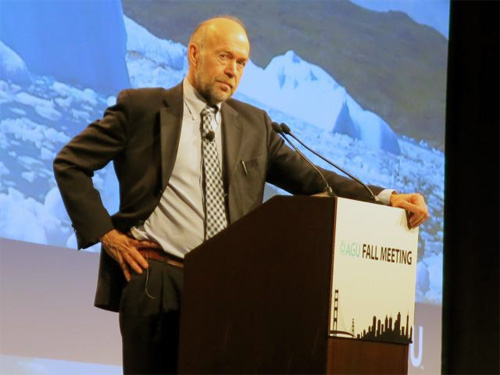 Alaska Science
Alaska Science
Climate researcher says there’s still time,
but not much
By NED ROZELL
February 03, 2014
Monday PM
(SitNews) - Painting the breeze one dozen at a time, monarch butterflies once fluttered across the meadow of James Hansen’s Pennsylvania farm. Now, the climate activist and his wife are lucky to see one. Monarchs are threatened by lack of the only food — milkweed — they eat as caterpillars. Herbicides, land clearing and other people-related activities may be dooming the monarchs.
“I wonder if we are witnessing the extermination of a species,” Hansen, the 73-year-old longtime NASA researcher said to a crowd of about 3,000 people in San Francisco’s Moscone Center. Hansen was the headline speaker at the Fall Meeting of the American Geophysical Union, attended by more than 20,000 scientists in December 2013.

Climate scientist James Hansen speaking at the Fall Meeting of the American Geophysical Union in San Francisco in December 2013.
Photograph by Ned Rozell
Hansen used “extermination” for its implication that people have a choice on some matters, such as the survival of more complicated species.
“There is still an opportunity for humanity to exercise free will,” he said. “It’s still possible to get on a different path, but not if we don’t try.”
Hansen was talking about the warming effects of increased carbon dioxide in the atmosphere, the result of fossil fuel emissions. He spoke to the crowd of scientists in San Francisco about the perils of pushing our planet into a state that will be at best uncomfortable for humans.
After a 46-year career with NASA during which he studied, among many other things, the clouds of Venus, Hansen retired in April 2013. One of the reasons is because government employees are forbidden from suing the government.
Hansen is part of a lawsuit against the United States in which plaintiffs argue the government is obligated to protect the atmosphere from harmful greenhouse gases. He and many others see Earth’s 30-mile shell of life-enabling vapors as a public trust.
“Today’s adults must deliver to their children and future generations an atmosphere as beneficial as the one they received,” Hansen wrote in a recent paper he co-authored with 17 scientists titled Assessing “Dangerous Climate Change:” Required Reduction of Carbon Emissions to Protect Young People, Future Generations and Nature.
In his talk, Hansen pointed out that humanity cannot keep operating as it is and expect a friendly planet. There will simply be too many greenhouse gases in the atmosphere, preventing heat from wafting out to space and further weighting the planet’s energy imbalance. In an ideal state, Earth radiates as much energy to space as it absorbs from sunlight.
“We can’t burn all the fossil fuels and we’re going to have to phase out coal use,” he said. “We already used up most of our carbon budget.”
Along with mentioning ice sheet disintegration, sea level rise, species extinction and climate extremes, Hansen also said he realizes that suing his government is not going to change much. He sees human-made climate change as a moral issue and hopes people will rise to action as they did against slavery and for civil rights.
His plan of action includes a “carbon fee,” which he proposes as an agreement between the world’s two largest emitters of carbon, the United States and China, “with a border duty imposed on products from nations without a carbon tax, which would provide a strong incentive for other nations to impose an equivalent carbon tax.”
Governments would issue dividends from the carbon tax equally to all residents. Economic modelers Hansen cited in his paper suggested that the higher prices people would pay for gasoline and fuel oil would be offset by the dividends.
Nuclear power is also an essential part of the equation, said Hansen, as is reforestation of much of the globe (trees and other large plants are marvelous at sucking up carbon).
With fuel companies not paying the true price for extracting the resource and passing on that lack of cost to consumers, it’s hard to get the masses concerned, he said.
“It’s much easier just to avoid the topic, and that seems to be what we do,” Hansen said. “This is a very hard problem to deal with and we’re running out of time.”
Time may indeed be short for monarch butterflies. In late January 2014, researchers for the World Wildlife Fund Mexico calculated that concentration of monarch butterflies overwintering on trees there is at its lowest concentration since biologists began monitoring them in the winter of 1994-1995.
Since the late 1970s, the University of Alaska Fairbanks' Geophysical Institute has provided this column free in cooperation with the UAF research community.
Ned Rozell [nrozell@gi.alaska.edu] is a science writer for the Geophysical Institute.
E-mail your news &
photos to editor@sitnews.us
Publish A Letter in SitNews
Contact the Editor
SitNews ©2014
Stories In The News
Ketchikan, Alaska
|
Articles &
photographs that appear in SitNews may be protected by copyright
and may not be reprinted without written permission from and
payment of any required fees to the proper sources.
|
|

